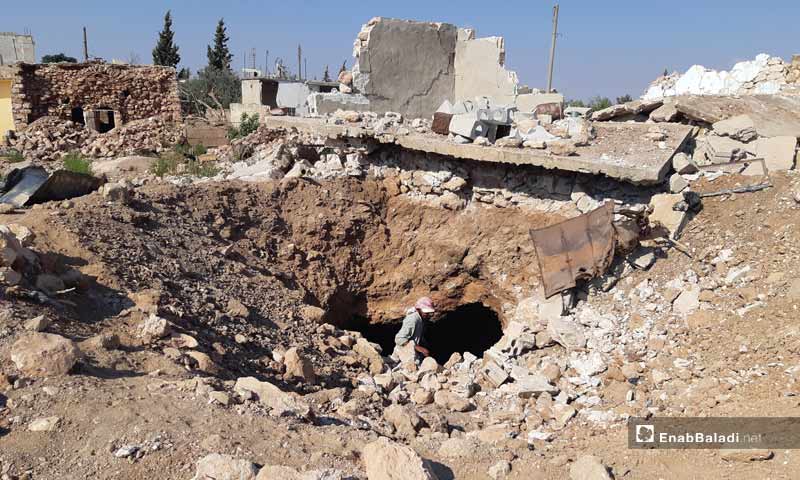



Escaping the aerial and the missile bombing, Ali Hamoud and his children have turned to one of southern Idlib’s caves to live, for the agony of staying in a rocky underground cavity, according to Ali, is less dangerous than the rockets and mortars that have been relentlessly targeting his village and house for months.
Hamoud, nicknamed Abu Abdo, sought a hiding place in the cave, he dug years ago using simple tools to protect his family, after he was forcibly displaced from his hometown of Maar Tahroma, south of Idlib, driven by the military campaign carried out by the Syrian regime forces and its ally, Russia.
In southern rural Idlib, numerous internally displaced persons (IDPs) live in rocky caves, which are underground shelters they dug earlier on taking advantage of the area’s terrain, becoming their only place of refuge in the face of the airstrikes the area is enduring.
Living in caves, Hamoud told Enab Baladi, has a dangerous side to it, such as high humidity, lack of ventilation and exposure to sunlight, which affect cave residents’ health, particularly children and elderly.
Inside the caves, the lives of IDPS are also threatened with the spreading insects, reptiles, snakes and scorpions which sneak into the caves, not to mention the fatality of inhaling the smoke and dust resulting from bombardment, making the people vulnerable to suffocation.
Despite the peril of living in the ground hole, Hamoud finds in the cave life a safer and more secure choice compared to returning to his village, which aerial shelling intimidates akin to the rest of the towns in southern rural Idlib, with the area being void of its population.
Also living in one of the area’s caves, Hafez al-Hamwi, for his part, told Enab Baladi that to buy his needs, he must travel 15 kilometers a day.
The doctor at Hama Healthcare Directorate, Salem al-Sayed, said that of the hazards that mainly threaten the lives of cave seekers is the damage that might befall the respiratory system, for living in a cave causes allergies that may develop into infections, in addition to asthma, especially among children, which results from high humidity.
In an interview with Enab Baladi, the doctor indicated that the IDPS are at risk of sustaining other diseases, including skin diseases since the cave provides a suitable environment for sand flies, which cause leishmaniasis, and lice among other insects. There are also eye-related diseases and growth disorders due to temperature inconsistencies and spending long hours in these ground holes.
The caves are not protected from aerial bombardment, for they cannot survive the Russian bombs in particular, the Syria Civil Defense’s Official in Idlib, Mustafa al-Haj, said, stressing that the concussion bombs dropped by Russian aircraft have already destroyed caves, shelters and underground hospitals.
These caves are not enough to be a permanent residence for the IDPS, but they are their only shelter during military escalation, especially aerial shelling, and they may live there for a long time, Haj Youssef added.
IDPs living in caves consider reconnaissance aircraft the greatest danger, for they never part with the area’s airspace, monitoring any human movement, especially at night, turning the IDPs into a potential target for warplanes at any moment.
In the past few weeks, the areas of southern and eastern Idlib countryside have been subjected to a military campaign conducted by the Syrian regime, covered by the Russian Air Force. In sync, land clashes helped the regime and its allies take over the area of Khan Shaykhun, south of Idlib, and the full range of the northern countryside of Hama.
Since the beginning of the military campaign in Idlib and Hama countryside, 948,000 persons have been displaced between February 2 and August 26, according to the figures of Syria Response Coordinators Group (SRCG) in northern Syria.
if you think the article contain wrong information or you have additional details Send Correction